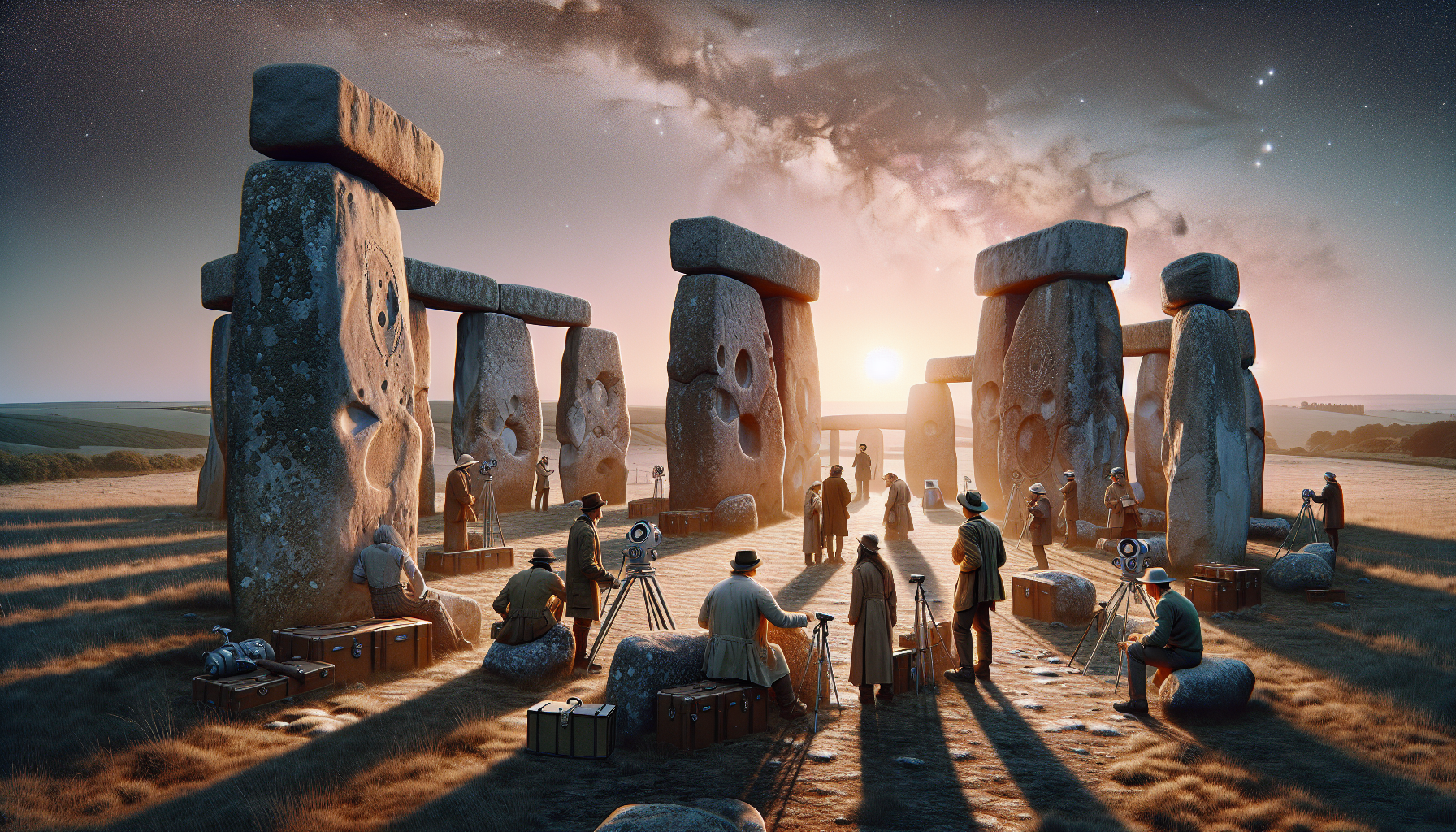In the vast tapestry of human history, there are few enigmas as captivating and profound as the ancient henges scattered across the landscapes of Europe. These megalithic structures, with their colossal stones and mysterious layouts, have long piqued the curiosity of archaeologists, historians, and adventurers alike. But beyond their imposing physical presence, what true purpose did these henges serve for the ancient civilizations that constructed them? Recent research suggests that these iconic sites were far more than mere gathering places or ceremonial grounds; they functioned as sophisticated observatories, allowing our ancestors to unlock the secrets of the cosmos. Join us as we embark on a journey to unravel the mysteries of these ancient observatories and explore the astronomical ingenuity of the people who built them.
As we delve into the world of ancient henges, we’ll uncover the intricate relationship between these structures and the celestial bodies that guided the lives of early societies. From the renowned Stonehenge in England to the lesser-known but equally fascinating henges across the British Isles and beyond, we’ll examine how their strategic placements and alignments reveal an advanced understanding of astronomy. These megaliths were not merely erected at random; their orientations suggest intentional design, aligning with solar and lunar cycles, solstices, and equinoxes. Through the lens of archaeology and modern technology, we’ll piece together how these ancient engineers observed the skies, tracked time, and possibly even predicted celestial events.
Throughout this exploration, we’ll also address the cultural and spiritual significance of henges, considering how these structures were integral to the societies that created them. Were they centers for ritualistic ceremonies, places of communal gathering, or even portals to the divine? By synthesizing archaeological evidence with mythological and historical context, we’ll paint a comprehensive picture of how these enigmatic monuments served multiple purposes, intertwining the scientific with the sacred. Join us as we journey into the past to unveil the mysteries of ancient henges, and discover how these monumental observatories connected humanity with the cosmos in ways that continue to inspire wonder and curiosity today. 🌟
The Origins of Ancient Henges
Henges, mysterious and monumental structures, have long captivated archaeologists and historians alike. These circular earthworks, often accompanied by standing stones or wooden posts, are scattered throughout the British Isles and parts of Europe. Despite their prominence, their true purpose remains an enigma, sparking numerous theories about their function and significance in ancient societies. Uncovering the mysteries of these megalithic structures involves delving into their origins, construction techniques, and potential uses as ancient observatories.
The earliest henges date back to the Neolithic period, around 3000 BCE. The construction of these vast earthworks required a significant amount of labor and resources, suggesting that they held considerable importance for the communities that built them. Archaeologists have identified over a thousand henges, with Stonehenge being the most famous among them. However, other notable examples include Avebury and the Ring of Brodgar. Each of these sites exhibits unique characteristics, yet they all share the common feature of a circular layout, indicating a shared cultural or religious significance.
One of the primary challenges in understanding the purpose of henges lies in the lack of written records from the Neolithic era. This absence of documentation leaves researchers to rely heavily on archaeological evidence and comparative analysis with other contemporary structures. As we uncover more about these ancient sites, we gain insight into the complex societies that constructed them, revealing their technological capabilities, social structures, and potential spiritual beliefs.
Construction Techniques and Challenges
Building a henge was no small feat, requiring careful planning and precise execution. The construction process typically began with the excavation of a circular ditch, the soil from which was used to form an inner bank. This bank, often several meters high, enclosed the central area, creating a boundary that likely served both practical and symbolic purposes. The placement of standing stones or wooden posts added another layer of complexity, as these elements were often sourced from distant locations and required considerable effort to transport and erect.
Understanding the construction techniques used by Neolithic builders sheds light on their impressive engineering skills and resourcefulness. The alignment of stones and posts with celestial events, such as solstices and equinoxes, suggests that these structures served not only as communal gathering places but also as rudimentary observatories. This astronomical alignment required a deep understanding of the natural world, indicating that the builders possessed advanced knowledge of celestial patterns and their significance.
Despite the challenges posed by the construction of henges, their enduring presence across the landscape attests to their significance in ancient societies. The collaborative effort required to build these structures implies a high degree of social organization and cooperation, highlighting the importance of henges as centers of community life and cultural expression.
The Role of Henges as Astronomical Observatories
The theory that henges functioned as ancient observatories is supported by their alignment with celestial events. This alignment allowed Neolithic peoples to track the movement of the sun, moon, and stars, providing a means to measure time and navigate their environment. The precise positioning of stones and posts suggests that these structures were designed with astronomical observations in mind, serving as both practical tools and symbols of cosmological knowledge.
One of the most compelling pieces of evidence for the use of henges as observatories is the alignment of Stonehenge with the summer solstice sunrise. On this day, the sun rises directly over the Heel Stone, casting a shadow that extends into the heart of the stone circle. This alignment is too precise to be coincidental, indicating that Stonehenge’s builders possessed a sophisticated understanding of solar movements and their significance in marking the passage of time.
Other henges, such as the Ring of Brodgar, also exhibit alignments with celestial events, further supporting the hypothesis that these structures served as observatories. The placement of stones in relation to the sun and moon suggests that Neolithic peoples used henges to track lunar cycles and predict eclipses, providing a valuable tool for agricultural planning and ritual observance.
Comparative Analysis of Henge Alignments
| Henge | Alignment | Celestial Event |
|---|---|---|
| Stonehenge | Heel Stone | Summer Solstice Sunrise |
| Avebury | Central Circle | Equinox Sunrise/Sunset |
| Ring of Brodgar | Standing Stones | Lunar Cycles |
Check out the table above to explore how different henges align with specific celestial events. Such alignments suggest a shared cultural practice of using henges as tools for timekeeping and astronomical observation.
The Cultural and Ritual Significance of Henges
Beyond their role as observatories, henges likely held deep cultural and ritual significance for the societies that constructed them. These structures served as focal points for communal gatherings, ceremonies, and rituals, reinforcing social bonds and cultural identity. The circular layout of henges may have symbolized unity and continuity, reflecting the cyclical nature of time and the cosmos.
The presence of burials and ceremonial artifacts at some henge sites suggests that these structures also functioned as sacred spaces for ancestor worship and spiritual practices. The act of constructing a henge itself may have been a ritualistic endeavor, involving the entire community in a shared project that connected them to their ancestors and the divine.
Henges also served as venues for seasonal festivals, marking important transitions in the agricultural calendar. These gatherings provided opportunities for trade, social interaction, and the exchange of knowledge, strengthening the cultural and economic ties between different communities.
Exploring the Symbolism of Henges
- Circular layout symbolizing unity and continuity
- Alignment with celestial events representing cosmic order
- Role in seasonal festivals and communal gatherings
By examining the symbolism of henges, we gain insight into the spiritual beliefs and cultural practices of ancient societies. These structures served as tangible manifestations of cosmological knowledge, connecting the human and divine realms through their alignment with the stars.
Modern Interpretations and Research
In recent years, advances in technology have opened new avenues for researching and interpreting henges. Techniques such as ground-penetrating radar, 3D modeling, and drone photography allow archaeologists to explore these sites in greater detail, uncovering new evidence and refining existing theories about their purpose and significance.
Modern research has also highlighted the importance of interdisciplinary approaches in studying henges. By combining insights from archaeology, astronomy, anthropology, and other fields, researchers can develop a more comprehensive understanding of these complex structures and their role in ancient societies.
Public interest in henges remains strong, with many visitors drawn to their enigmatic presence and historical significance. This fascination has inspired numerous documentaries, books, and online resources, providing accessible avenues for learning about these ancient wonders.
Continuing the Exploration
As we continue to explore the mysteries of ancient henges, it is important to engage with the latest research and discoveries. Stay informed by watching documentaries and reading articles that delve into the latest findings about these fascinating structures.
For those interested in learning more, consider watching this informative video on the role of henges as ancient observatories: “Secrets of Stonehenge” by National Geographic. 📽️
By engaging with these resources, you can deepen your understanding of henges and their enduring impact on our understanding of history and culture. 🏛️

Conclusion
Unveiling the mysteries of ancient henges has been an enlightening journey through time, offering us a window into the lives, beliefs, and scientific understandings of our ancestors. Throughout this article, we have delved into the architectural marvels of these megalithic structures, exploring their roles as ancient observatories and highlighting their significance in the broader context of human history.
Initially, we examined the intricate construction of henges, noting how these circular earthworks and stone arrangements were meticulously designed. This points to a sophisticated understanding of architecture and an organized communal effort in their construction. We discussed the alignment of these structures with celestial bodies, such as the sun, moon, and stars, illustrating their function as tools for astronomical observation. Such alignments were not arbitrary; they were crucial for ancient societies to track time, seasons, and agricultural cycles, thereby playing an essential role in their survival and cultural practices.
Furthermore, we explored the cultural and spiritual dimensions of henges, emphasizing their role as sacred spaces for rituals and gatherings. The presence of artifacts and burial sites within and around these structures indicates that they were also places of reverence, possibly serving as portals between the earthly and divine realms. This dual role of henges as both observatories and sacred sites underscores the holistic worldview of ancient peoples, who intertwined their understanding of the cosmos with their spiritual lives.
The significance of these discoveries cannot be overstated. As we uncover more about henges, we gain insights into the ingenuity of early civilizations and their profound connection to the natural world. Understanding how they observed and interpreted celestial events enriches our appreciation for human innovation and the timeless quest for knowledge.
In reflecting on the relevance of ancient henges today, we find that they offer us valuable lessons in sustainability, community, and the pursuit of knowledge. These structures remind us of the importance of living in harmony with nature and the power of collective human effort in achieving monumental feats.
As we conclude this exploration, it’s essential to recognize the enduring legacy of henges and what they symbolize for modern society. They stand as a testament to human curiosity and the desire to understand our place in the universe. The study of ancient henges continues to inspire contemporary astronomers, architects, and historians, encouraging interdisciplinary collaboration and innovation.
We invite you, dear reader, to carry forward the lessons learned from ancient henges. Consider how these megalithic structures, with their blend of science, art, and spirituality, can inspire modern endeavors. Whether you’re an academic, a professional, or someone with a keen interest in history and archaeology, there’s much to gain from applying the principles of observation, community, and reverence for nature in your life and work.
Feel free to share this article with others who might be fascinated by the mysteries of ancient civilizations. Engage in discussions that explore the connections between past and present, and how ancient wisdom can inform contemporary challenges. By doing so, you contribute to a broader understanding and appreciation of our shared human heritage.
For further exploration, consider visiting these active resources that delve deeper into the world of ancient henges and their significance:
1. English Heritage’s comprehensive overview of Stonehenge: English Heritage – Stonehenge
2. National Geographic’s insights on megalithic structures: National Geographic – Megaliths
3. The British Museum’s collection and research on prehistoric Britain: British Museum – Prehistoric Britain
Thank you for embarking on this journey with us. Together, let’s continue to unveil the mysteries of our ancient past, keeping the spirit of inquiry and discovery alive for generations to come. 🌟
Toni Santos is a visual storyteller and cosmic interpreter whose work illuminates the ancient skywatchers and their prehistoric astronomy—the profound ways early humans observed and revered the heavens before written history. Through a visionary lens, Toni explores how the stars, planets, and celestial cycles shaped myth, ritual, and survival in cultures lost to time.
Rooted in a fascination with archaic observatories, stone alignments, and celestial symbolism, Toni’s creative journey reveals the deep human impulse to understand and harmonize with the cosmos. From lunar phases guiding planting seasons to the sacred paths of the Milky Way, each of his works embodies the awe and knowledge encoded in the night sky.
Combining artistic craftsmanship with archaeological insight, Toni’s pieces evoke the mystery and precision of prehistoric astronomers. His work does more than depict—it channels the timeless dance between earth and sky, bridging ancient wisdom with contemporary wonder.
As the visionary behind Vizovex, Toni shares curated visuals, essays, and symbolic studies that invite others to reconnect with the cosmic heritage written in stone and starlight. His creations are a call to look upward, to listen to the silent stories told by the stars, and to honor the first astronomers who mapped the heavens with reverence and ingenuity.
His work is a tribute to:
The celestial wisdom of prehistoric peoples
The sacred geometry of ancient observatories
The enduring bond between human culture and the cosmos
Whether you’re a stargazer, a scholar of ancient mysteries, or someone captivated by the universe’s earliest storytellers, Toni welcomes you to journey through a space where the sky is both map and myth—one constellation, one ritual, one revelation at a time.




